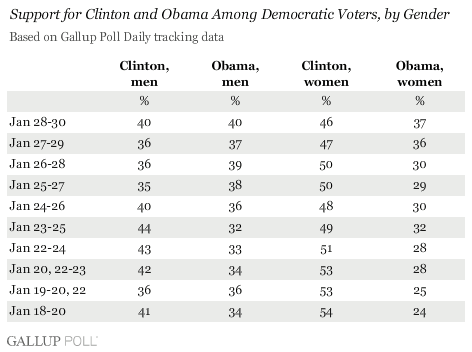PRINCETON, NJ -- Sen. Hillary Clinton, the first woman to become a front-runner for her party's presidential nomination, has enjoyed disproportionately strong support from female voters. For example, an analysis of 11,794 interviews conducted with Democratic voters since Jan. 2 of this year shows that Clinton receives the vote of 48% of women, compared to 38% of men.
But in recent days, the overall gap between Clinton and her only remaining serious competitor, Sen. Barack Obama, has been closing, and an analysis of the patterns of vote choice by gender shows that Obama's gains over the last 10 days have come disproportionately among women. Clinton has been losing more support from women than from men, in essence moving closer to a point where the "gender playing field" has been leveled.
The accompanying table displays the trend in vote choice between Clinton and Obama by gender for the three-day rolling averages of polls conducted over the last 10 days. Comparing the three-day average of polls conducted Jan. 18-20 to the three-day average of polls conducted Jan. 28-30 shows that while Clinton's level of support among men has essentially stayed the same, she has lost 8 points among women. At the same time, Obama has gained 6 points among men, but has gained even more -- 13 points -- among women.

Whereas there was a 13-point difference between female and male support for Clinton in the Jan. 18-20 interviewing, there is now just a 6-point gap. And whereas Obama was operating with a 10-point deficit among women compared to his support among men roughly 10 days ago, that gender gap in support for Obama is now just 3 points. In general, the patterns of support for the two candidates by gender are much closer to one another than they were just 10 days ago. Gender now appears to make less of a difference.

The narrowing of the race by gender is apparent in most key subgroups of women, including by age, race, education, and marital status.
Implications
The major trend evident in the ���۴�ýPoll Daily tracking data over the last 10 days has been the narrowing of the race for the Democratic nomination. Obama has been gradually chipping away at Clinton's lead, to the point where he trails her by just a few points.
A detailed analysis of the patterns evident in the trend data over the last 10 days shows that Clinton's loss of support has occurred disproportionately among Democratic women. While Clinton is still supported by a higher percentage of Democratic women than Democratic men, the difference in that gender gap has shrunk from 13 points in interviews conducted Jan. 18-20 to just 6 points in Jan. 28-30 polling. Most of the change is because of a drop in support for Clinton among women (8 points), rather than an increase in support among men.
Clinton is the first female to become a major party's front-running candidate for the presidential nomination, and her particular appeal to female voters has long been considered one of her political strengths. If Obama continues to increase his appeal to women to the point where Clinton's gender gap is neutralized, she will have lost one of her most reliable bases of support going into next week's all-important Super Tuesday vote.
Survey Methods
These results are based on combined three-day rolling averages of Democratic voters. Each rolling average consists of data from interviews with approximately 1,200 national Democratic voters, 18 and older. For results based on these samples, one can say with 95% confidence that the maximum error attributable to sampling and other random effects is ±3 percentage points.
Each daily rolling average consists of interviews with approximately 600 male Democratic voters and 600 female Democratic voters. For results based on these samples, the maximum margin of sampling error is ±4 percentage points.
Interviews are conducted with respondents on land-line telephones (for respondents with a land-line telephone) and cellular phones (for respondents who are cell-phone only).
In addition to sampling error, question wording and practical difficulties in conducting surveys can introduce error or bias into the findings of public opinion polls.
